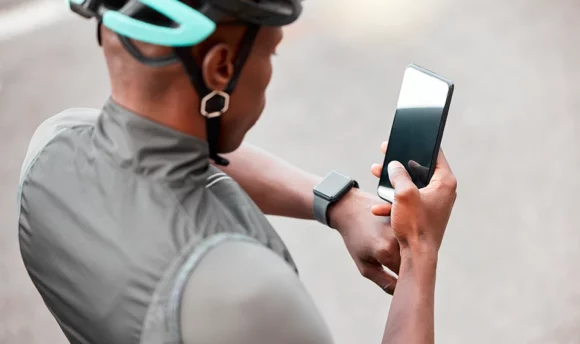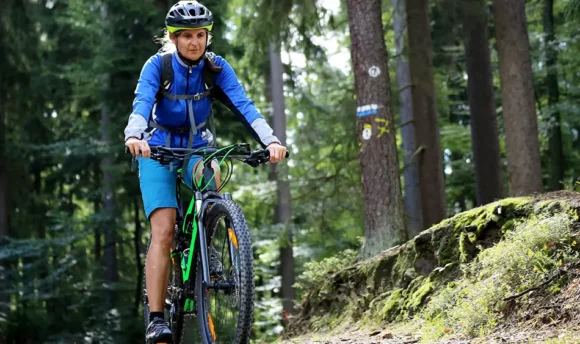How Long Does It Take to Bike 3 Miles?
Want to bike a mile or 3? Learn how long it’ll take to ride 3 miles, its benefits, and if it’s enough for weight loss.

If you need a quick fat-burning formula or exercise, it doesn’t exist. What does exist is a sustainable, steady, and reasonable exercise like cycling that helps you melt off that excess body fat at a sustainable rate.
However, beginners might find it hard to maintain longer distances. That’s why it’s vital to begin your journey with a low distance, like a 3-mile trail ride.
So, how long does it take to bike 3 miles, and what are the benefits of cycling that distance? In this article, we will explain that and more.
How Long Does It Take to Bike 3 Miles?
The average time it’ll take to bike three miles is between 6 to 12 minutes. Your ride time may differ from this depending on several factors.
A recreational cyclist on regular terrain, biking at a rate of 18 mph, will cover the 3-mile distance in 10–12 minutes. For professional cyclists, this would take six minutes, with a biking speed of 28 miles per hour.
The same regular biker on hilly terrain will take between 20 to 24 minutes to finish three miles. Professional riders will take around ten to twelve minutes.
Note that a person’s average speed to bike a mile will depend on several factors, including gender, age, bike types, fitness level, terrain, etc. For example, you’ll ride faster on a downhill or flat road than if you were going uphill or on a mountain track.
The ride duration of your bike trips also depends on the bike types you use to bike a mile. This may include a mountain bike, road bike, or touring bike. Some bikes will cover more miles per hour than others.
How Many Calories Does a 3-Mile Bike Ride Burn?
According to a Harvard study, a 3-mile bike ride burns about 145 calories for a 150-pound cyclist paddling at an average speed of 12 miles per hour. Increasing the speed to 14 miles per hour would see the cyclist hitting higher calories burned.
You’ll need to eat a balanced and well-thought-out diet to burn more calories when you bike a mile or more. Unfortunately, eating too many carbs or not enough calcium prevents you from burning more calories.
5 Benefits of Biking 3 Miles Every Day
Biking has immense benefits. It’s a great place to start if you need a fun exercise to get you sweaty and increase your heart rate.
By riding a bike, a recreational or professional cyclist improves their mental health and physical health. Read on for more benefits of riding 3 miles a day.
#1 Cycling helps you lose weight and build muscle
Burning enough calories depends on how much of a calorie deficit you’re on. Usually, this should be within a healthy range for your current weight. Combined with an optimized meal plan, bike riding helps you increase calories burned and lose healthy weight.
In addition to the weight shedding benefits, the resistance part of cycling helps you engage your muscles and build muscle strength in the calves, glutes, hamstrings, and quads. So while you wouldn’t look like Arnold Schwarzenegger, you’ll have some nicely toned muscles.
As you work those muscles on your bike ride, remember that you shouldn’t depend on cycling to gain overall muscle strength and definition. If you want more than the usual biking muscle tone, you must include other strength training exercises.
#2 Cycling offers a less time-consuming alternative for transportation
Imagine you’re running a short errand and don’t feel like walking the distance or calling a taxi. Driving might get you in traffic, and a bus could drop you too far from your destination.
Instead of sitting in traffic, mount your bike and ride to the store or your neighborhood market. You’ll save time and put in a good workout while at it.
Also, by choosing cycling instead of a car or bus ride, you’re doing your part to reduce carbon emissions and save the planet in the long run.
Biking also saves you money on gas and bus fares. In addition, it’s an accessible mode of transportation that keeps you active during your short journey and prevents you from sitting stationary in traffic for too long. Also, those short journeys increase the average time spent biking.
#3 Cycling improves your lung health
According to a study by Europa.eu and two other organizations, cyclists encounter less air pollution than those using other ground transportation. The study monitored those who commuted by car, walking, and cycling on busy roads and quieter routes.
They found that the pedestrian was exposed to much higher air pollution as they spent more time on the road breathing in fumes and clouds of dust that didn’t disperse quickly.
The motorists, including the driver and passengers, breathed in more polluted air as exhaust fumes from the front and the back didn’t disperse quickly, especially in stand-still traffic. In addition, the study showed that being inside a car does not exempt you from exposure to exhaust fumes.
On the other hand, the cyclist experienced far less exposure because the air quickly dispersed as they rode, and they spent less time on the road than the pedestrian.
#4 Cycling improves heart health and reduces cancer risk
Cycling as an exercise increases your heart rate, gets the blood pumping more, and increases the number of calories burned. As a result, riding a bike improves your health, keeps your heart safe, and reduces your risk of developing life-changing heart and cancer-related diseases.
In a recent study by the University of Glasgow, researchers studied a group of over 200 commuters. They wanted to know how their mode of transportation affects their health risk for incident cardiovascular disease (CVD), cancer, and all-cause mortality.
The study concluded that riding helped lower cyclists’ risk of cancer and cardiovascular disease compared to those who walked or used motor vehicles.
#5 Cycling improves spatial awareness
Do you ever know the distance between you and an object you’re about to reach? Or your ability to use a map while driving or walking? This ability to mentally tell the distance between objects in your environment relative to your position is called spatial awareness.
Cycling involves cornering, descending and ascending, and weaving between trees and people, depending on rough or smooth terrain. Your ability to use your body weight and manipulate the bicycle’s controls to go where you want it to helps improve your spatial awareness.
Also, riding a bike improves your internal navigational skills. You may have to navigate areas without an internet connection, forcing you to figure out the route on your own.
FAQs
Yes, 3 miles daily is enough to lose some weight as long as you’ve created a calorie deficit.
It could take 30 to 35 minutes to bike 5 miles. Regular and consistent practice on a flat surface can bring it down to 20 minutes.
The average person rides at 15 miles per hour. Your speed would depend on the terrain, physical fitness, and weather conditions.
A Word From Our Coach
Once you get the hang of it, cycling becomes a fun and rewarding activity. However, if you want to bike a mile faster or more efficiently, consider getting proper clothing and bike type.
You’ll require different types of bikes to bike a mile or longer distances. Road bikes work best if you’re planning to ride on flat terrain. However, for bikers looking to ply a rough terrain with gravel, mountain bikes are built for such a task.
Mountain bikes are slower than road bikes but are specifically created to handle mountainous terrain. Touring bikes are more for riding longer distances and can reach speeds of 13 miles per hour.
In all this, remember that a downhill race removes some pressure from your paddling muscles but can reduce your mile time to one minute. It also encourages coasting, reducing the number of calories you’ll burn during your ride.
Lastly, if you want to know your average speed, calculate your distance covered and time spent riding. Then, divide the distance by your ride duration in minutes and multiply it by 60.
Conclusion
How long it takes to bike a mile or three depends on several factors like a person’s fitness, terrain, type of bike, gender, etc. For example, your average bike speed will increase if you’re on a downhill mile ride and decrease on an uphill one.
By cycling 3 miles daily, you’re developing a healthy heart and lungs, reducing weight, and improving mental health and spatial awareness. You’ll shed weight sustainably while you bike a mile and enjoy all the benefits.

















































 Select your language:
Select your language: 








